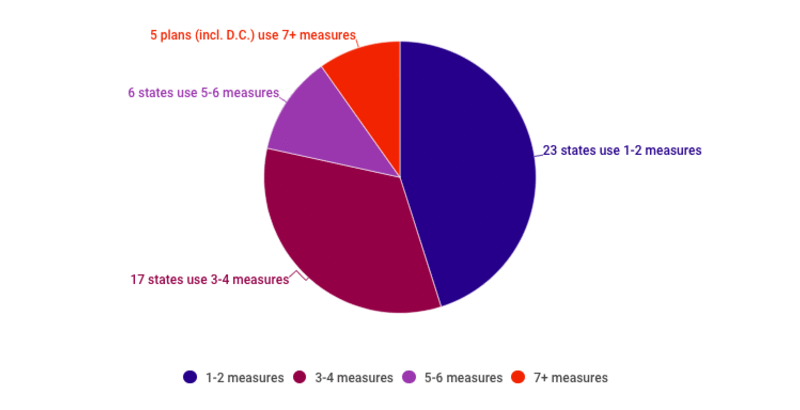Educators Hoped ESSA’s ‘5th Indicator’ Would Paint a Clearer Picture of Student Success. But With Some States Now Choosing Up to 11 Different Measures, Experts Worry Results Are a ‘Hodgepodge’

Academic achievement has typically been the gold standard for tracking student gains and school progress. But policymakers hoped recent changes to federal education law would spur a more innovative approach.
Under the 2015 Every Students Succeeds Act (ESSA), states submitted education plans last year to the U.S. Department of Education outlining at least five indicators. These indicators, when weighted and combined, should produce school scores that help states identify their lowest performers for improvement plans and designated federal funds.
The first four were explicitly academic: achievement, growth, graduation rates, and English language proficiency. The fifth indicator, however, was a true blank slate. (The law did suggest non-academic benchmarks such as student engagement and school climate and safety.)
Education experts widely consider the fifth indicator to be a positive step toward a more holistic view of student success. FutureEd editorial director Phyllis Jordan, in speaking with The 74, cited the education maxim, “What gets measured, gets done.”
But what’s getting done, exactly?
An in-depth review by The 74 of plans from 49 states and Washington, D.C., revealed that many fifth indicators are flooded with numerous, complex measures that, according to some critics, risk diluting educators’ focus and muddying improvement goals. And while the vast majority of plans use the fifth indicator to track chronic absenteeism, a smattering of other measures — from college and career readiness to science achievement — remain largely focused on academics.
Here are 6 notable findings from the plans:
1 Many states packed their fifth indicators with multiple (and complex) measures — and that might not be a good thing
States needed only one fifth-indicator measure to satisfy the law. But at least 20 plans pack in four or more.
This is especially notable at the high school level: 19 plans lay out four or more fifth-indicator measures for high schoolers, compared with only seven plans that do so for students in grades K-8. Experts largely attributed the variance to the added focus on college and career readiness in the later grades.
Arkansas’s fifth indicator is the most crowded, with 11 total measures.
Some of the metrics within the indicators are convoluted, too. While Kentucky’s fifth indicator has four measures, for example, one that centers on student equity lists about 20 benchmarks schools have to track, such as the percentage of students who’ve completed a visual and performing arts or world language class. And in Ohio’s plan, one fifth-indicator measure is identified as a subset of the achievement indicator, which already has up to 29 state testing metrics.
Anne Wicks, director of education reform at the George W. Bush Institute, warned that the resulting “hodgepodge” could hinder states’ progress. This is especially true given that under ESSA, the fifth indicator must have a substantially lower weight than the combined academic indicators — and therefore less clout — within schools’ total accountability scores.
A plan with two or so measures “is different than a [plan] that has 10,” she said. “There’s less clear direction to the educators in charge of the day-to-day implementation.”
2 Chronic absenteeism was the most consistent measure across states’ plans
Thirty-six states and Washington, D.C., adopted chronic absenteeism as a measure, making it the most favored fifth indicator.
There are several reasons for its popularity. Chronic absenteeism has spiraled into a nationwide crisis, with about 16 percent of K-12 students reportedly missing 15 or more school days during the 2015-16 year. Chronic absence also links to poor academic performance, delayed graduation, and higher dropout rates, and it correlates strongly with school climate issues such as bullying and poor transportation.
Thirty-three of these plans include chronic absenteeism for all grades. Four states — Arizona, Colorado, Indiana, and South Dakota — limit the measure to grades K-8.
3 College and career readiness: another standout
About three-quarters of state plans delineated at least one measure of college and career readiness — though the criteria vary significantly.
Georgia’s single college/career-readiness measure, for example, tracks the percentage of seniors who meet one of eight benchmarks, such as entering the University System of Georgia “without needing remediation,” scoring a 22 or higher on the ACT, or “completing a work-based learning experience.” Texas’s measure follows a similar framework but addresses alternative postsecondary options, including military enlistment, industry certifications, and admittance into certification programs.
Arkansas, meanwhile, has six separate measures for its seniors — earning a 2.8 or better grade point average on a 4.0 scale and collecting “community service learning credits” are two of them.
Although postsecondary readiness, like school climate, was expressly recommended in ESSA as a potential fifth indicator, the resulting torrent of related measures epitomizes the “dilut[ion] of school districts’ focus on non-academic contributors to student success,” FutureEd reported.
4 A missed opportunity for school climate?
School climate, including the development of social-emotional learning skills and access to healthy nutrition, plays a key role in students’ academic performance. So some educators and experts suggested metrics such as student engagement or a school climate survey for the fifth indicator, with the intent of helping states keep tabs on how students and educators perceive their respective learning and teaching environments.
Yet only eight states — including North Dakota, Illinois, New Mexico, and Maryland— adopted such a measure.
Among states that dove in, there’s no single approach. Maryland’s survey, distributed to all students and educators, asks about relationships, safety, environment, and engagement. North Dakota’s, meanwhile, looks specifically at students’ cognitive, behavioral, and emotional engagement.
States such as New York might adopt a school climate measure down the line. But overall, most states’ fifth-indicator choices were married to academics. A FutureEd report observed 22 repeated academic measures across state plans, versus four non-academic ones.
School climate is “not an easy thing to put into the accountability system if you’re not already doing it statewide,” Linda Darling-Hammond, president and CEO of the Learning Policy Institute, told The 74 last year. “It makes sense to me that very few states would be incorporating [it].”
5 Science and ninth-grade progress bring added academic focus
In a nod toward academics, science performance and high school freshmen’s headway toward graduation make consistent appearances in many state plans.
About 40 percent of states’ fifth indicators track science achievement — a not particularly shocking addition, given the nation’s dismal 24th place in international science rankings. The benchmark is often defined as student performance and/or growth on state science assessments.
A few state plans are more tailored. North Carolina, for example, is calculating the percentage of high schoolers with grade-level proficiency on an end-of-course biology test.
About one-sixth of state plans are also monitoring, in some form, whether high school freshmen are securing the necessary credits by the end of ninth grade to graduate on time. (Research suggests that students who are on track to graduate in four years by the end of ninth grade are 3.5 times more likely to actually graduate on time than peers who lag behind on credits.)
A few states veer away from that benchmark. Massachusetts selected general “success in grade 9 courses” as a measure, while Idaho is monitoring “students in grade 9 taking Algebra 1 or higher-level courses.”
6 A few states spice things up
While many states stuck with more commonplace fifth-indicator measures, some got crafty and ventured outside the proverbial box.
Arizona, within its “acceleration menu,” awards points to schools that integrate special education students. Schools where special education students make up 7 percent or more of the student population and spend 80 percent or more of their day in a general classroom are eligible.
Pennsylvania is one of the only states taking an interest in its elementary and middle schoolers’ career trajectories. Its career-readiness measure entails, among other things, calculating the percentage of students who “by the end of grade 5, demonstrate engagement in career exploration” and the percentage of students who “by the end of grade 8, create an individualized career plan and participate in career preparation activities.”
West Virginia is trying a different approach to tackling school suspensions with its “behavior” measure, which tracks the percentage of students who receive zero out-of-school suspensions during the school year — as opposed to recording suspension rates. The hope is to incentivize schools and educators to develop “alternative, non-exclusionary approaches to discipline” and “maximize student access to instruction.”
Vermont is putting one of its measures to work. The state’s physical-fitness component determines the percentage of students in a Presidential Youth Fitness Program (PYFP)-aligned “healthy zone.”
(Assessments can incorporate tests of aerobic capacity, abdominal strength, endurance, flexibility, and other activities, according to the PYFP’s website.)
Washington, D.C., reaffirmed its commitment to high-quality pre-K. The district currently serves nearly 90 percent of its 4-year-olds and 66 percent of its 3-year-olds under its lauded universal pre-K program. One of its fifth-indicator measures is the Classroom Assessment Scoring System (CLASS), which assesses “the quality of teacher-child interactions in early childhood classrooms.” The tool spotlights “three domains of teacher-child interaction that support student learning, including emotional support, classroom organization, and instructional support.”
Illinois is also in the process of identifying a pre-K-to-second-grade indicator to roll out in 2019-20. Chicago announced an expansive universal pre-K initiative in May.
To read more about your state’s fifth indicator measures under ESSA, click below:
Alabama (starting page 27)
Alaska (starting page 28)
Arizona (starting page 28)
Arkansas (starting page 50)
California (starting page 53)
Colorado (starting page 64)
Connecticut (starting page 40)
Delaware (starting page 39)
District of Columbia (starting page 20)
Florida (not approved) (starting page 22)
Georgia (starting page 33)
Hawaii (starting page 45)
Idaho (starting page 23)
Illinois (starting page 54)
Indiana (starting page 43)
Iowa (starting page 49)
Kansas (starting page 33)
Kentucky (starting page 60)
Louisiana (starting page 40)
Maine (starting page 40)
Maryland (starting page 27)
Massachusetts (starting page 47)
Michigan (starting page 33)
Minnesota (starting page 21)
Mississippi (starting page 23)
Missouri (starting page 25)
Montana (starting page 25)
Nebraska (starting page 80)
Nevada (starting page 48)
New Hampshire (starting page 40)
New Jersey (starting page 55)
New Mexico (starting page 84)
New York (starting page 62)
North Carolina (starting page 38)
North Dakota (starting page 41)
Ohio (starting page 32)
Oklahoma (starting page 42)
Oregon (starting page 45)
Pennsylvania (starting page 41)
Rhode Island (starting page 30)
South Carolina (starting page 43)
South Dakota (starting page 30)
Tennessee (starting page 78)
Texas (first link, starting page 23)
Utah (starting page 25)
Vermont (starting page 49)
Virginia (starting page 19)
Washington (starting page 35)
West Virginia (starting page 24)
Wisconsin (starting page 39)
Wyoming (starting page 21)
Get stories like these delivered straight to your inbox. Sign up for The 74 Newsletter

;)
